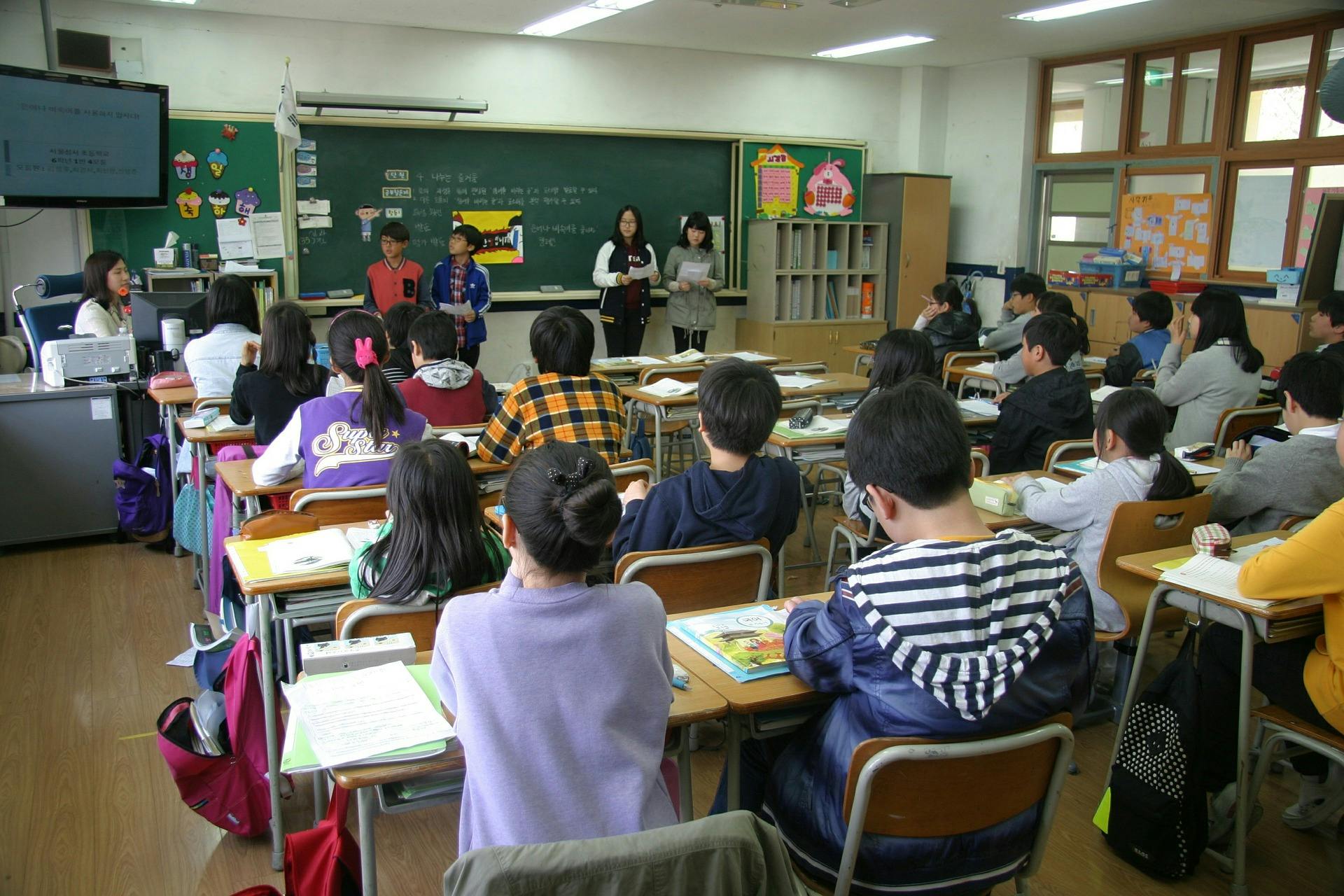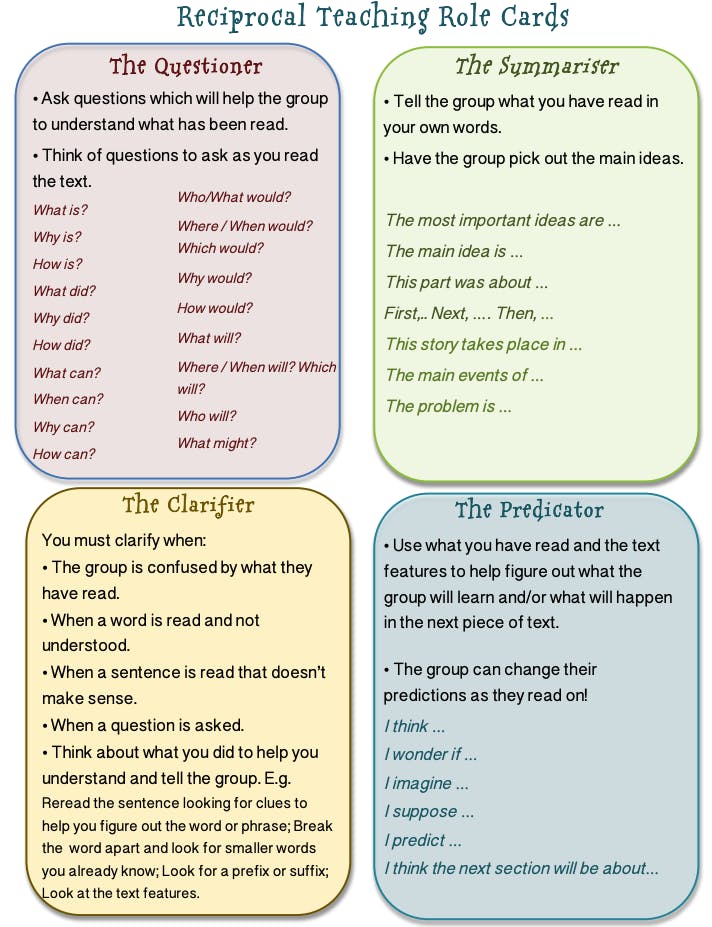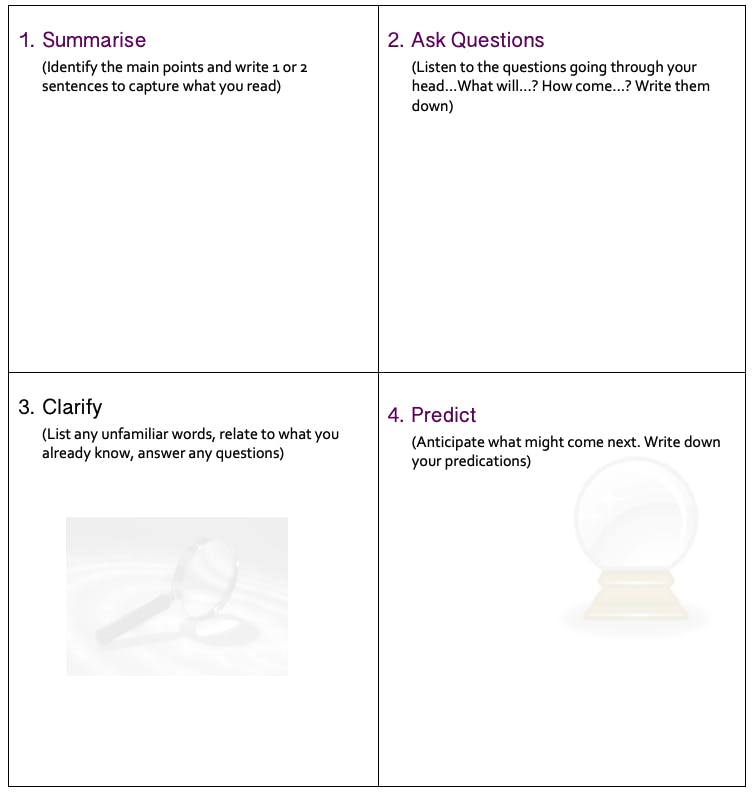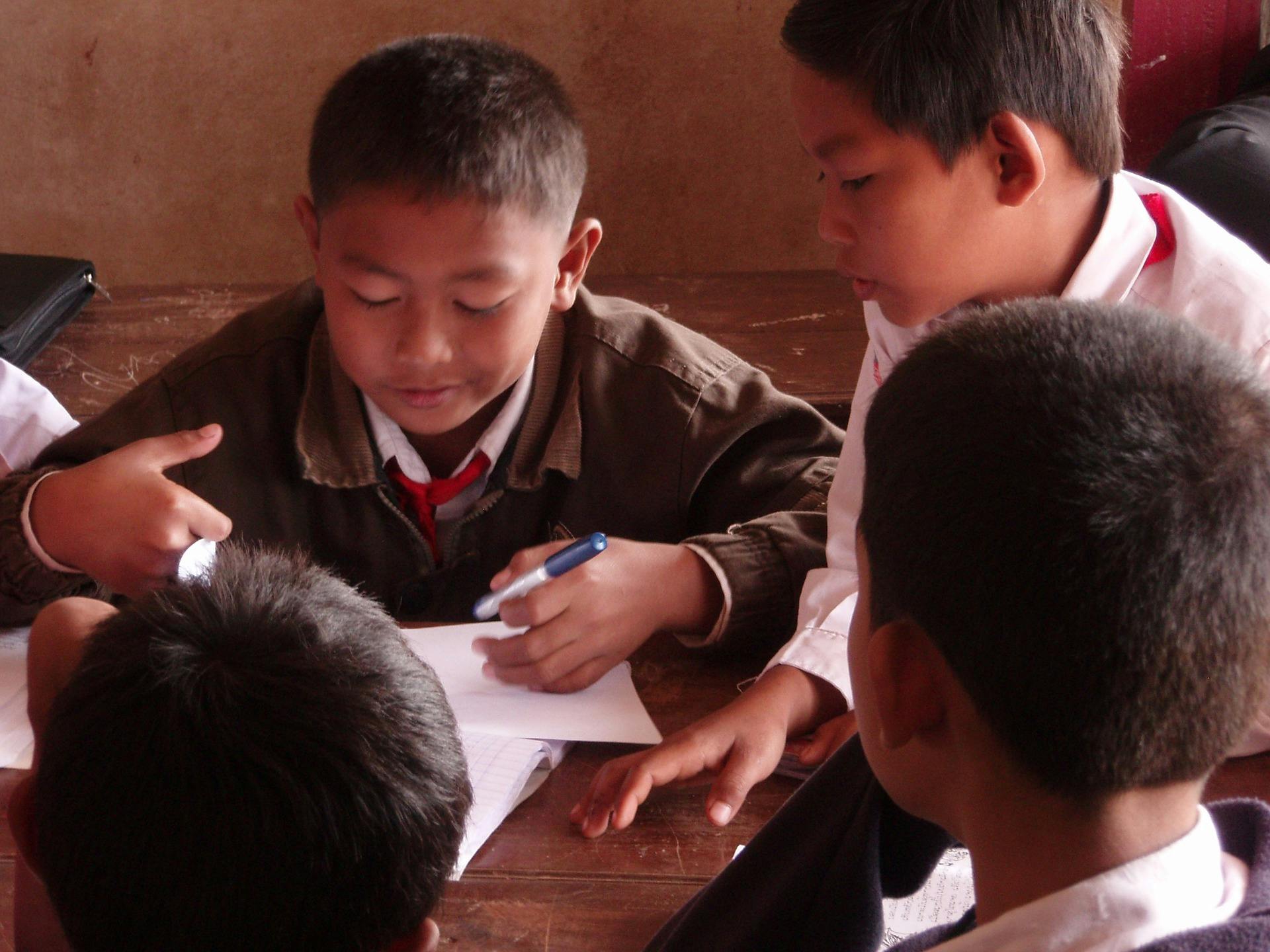How Reciprocal Teaching Can Make Your Students Confident Readers
All Posts
As a teacher, you know how difficult it can be to personalize learning to keep students interested in school subjects — especially when students don’t understand the subject matter. Reciprocal teaching strategies have been shown to increase student reading comprehension and improve overall literacy.
Reciprocal teaching not only helps with learning, but it also gets kids excited to participate in a lesson.
While this sounds amazing, what exactly is this strategy — and how do you introduce it to your classroom?
We’ll not only show you how reciprocal teaching works, but also how to incorporate it into your lessons. A 2009 study by Cooper and Greive suggests the skills used in reciprocal teaching go beyond helping students understand their readings. Their findings stated:
“… the experimental group benefited from [reciprocal teaching] strategies in ways other than knowledge of the content of the readings. They gave evidence of finding the process interesting and were enthusiastic in their involvement.”
Reciprocal teaching gets students excited to learn by actively involving them in readings, making them more likely to understand given texts.
What is reciprocal teaching?
Reciprocal teaching refers to a classroom activity where students are shown common comprehension strategies, in dialogue with the teacher and their peers, to better understand a text. These strategies get students more involved throughout the reading process, helping them stay engaged and improving their overall comprehension skills.
Reciprocal teaching follows the “I do, we do, you do” formula.
First, you demonstrate how the strategies work, then students work together in small groups to better understand the process, and finally, once students are comfortable, they use these strategies on their own.
What are the reciprocal teaching strategies?
There are four parts, or “building blocks” to improving reading comprehension and engagement, which are: predicting, questioning, clarifying and summarizing.
Each one of these building blocks plays an important role in helping students:
- Improve literacy — Rather than skipping over words they don’t understand, students are encouraged to figure out what they mean, helping them with current and future readings.
- Stay engaged — Students are actively looking for different clues and ideas throughout readings, helping them to stay interested in a text.
- Boost reading comprehension — The four building blocks give students the tools needed to decipher a text and understand the ideas being presented to them.
- Learn on their own or in groups — Reciprocal teaching puts students in the position to improve their reading comprehension through teamwork so they are better suited to work by themselves on future projects.
Reciprocal teaching strategy: the four building blocks

To understand these strategies, it’s important to think about how we learn while reading a text. Good readers naturally piece together words and understand ideas in written form, but how do they get there?
Sullivan Palincsar and Ann L. Brown developed the original reciprocal teaching strategies in their 1984 study. They demonstrated that using the “four building blocks” actively supports student reading comprehension.
Let’s look at each building block in more detail:
1. Predicting
There are two parts to “predicting” a text. The first involves predicting what is going to happen overall in a reading; the other involves predicting what is going to happen next in a section or chapter. They sound similar but both have different processes.
- Part 1 — Predict what will happen throughout a text by using the title, imagery (such as cover art), or even a brief summary. Then use those clues to make your prediction of what happens in the entire piece.
- Part 2 — Skim the next bit of text you’ve been assigned to read, and pick out certain words, sentences, or images. From that quick overview make a prediction as to what is going to happen next in the text.
You want your students to avoid broad predictions that don’t give any real insight into what a reading is about. Predictions should state what the reader thinks the author’s purpose is in a text and give evidence as to why the reader has come to such conclusions.
Encourage your class to phrase their answers with evidence, for example: “I think ‘X’ because of ‘Y’”.
Let’s say your class is covering World War ll in History class and your students are assigned Anne Frank’s The Diary of a Young Girl. You wouldn’t want simple predictions like, “I think it’s about a young girl who writes a diary”.
Rather, encourage your students to work harder and predict something in greater detail: “Based on the summary on the back of the book, I predict this book contains real diary entries from a teenage girl trying to survive with her family during the Nazi occupation of the Netherlands.”
Making a prediction with evidence will help students connect more with a text and activate prior knowledge — making them more involved in the reading process. When learners are involved with the text, they are more focused, which will help them understand what is happening throughout it.
2. Questioning
Admitting you don’t understand something is a crucial part of the learning process. You want your students to take the time to pause and write down questions they have as they read through a portion of a text.
You also want students to question why certain things are important within the reading. However, asking questions can be hard and many students don’t know where to start. The easiest way is to ask:
- Who?
- What?
- When?
- Where?
- Why?
- How?
Asking, discussing, and answering questions gets students involved with the reading, ensures they’re paying attention to important details and helps them use metacognitive strategies to make sense of a text.
Lori Oczkus, the author of Reciprocal Teaching at Work, observes:
“Younger students naturally wonder and ask questions about the world around them. When students are encouraged and taught to ask questions as they read, their comprehension deepens.”
3. Clarifying
Clarifying is used to make sure students continue to understand what they’re reading throughout the entire process. This could be as simple as identifying unknown words to something more complicated such as explaining the key concepts of a particular passage.
Clarifying is a two-step process where students:
- Identify that they are confused by an idea or word
- Take steps to resolve the confusion and better understand the text
Give your students a good idea of what it feels like to misunderstand a passage so they can identify this problem themselves. In the book, Reading Essentials: The Specifics You Need To Teach Reading Well by Regie Routman, the author states that many young readers don’t know when they’ve lost meaning in a text.
Students can get tripped up by long, complicated words, hard-to-interpret images such as graphs or tables, convoluted sentences, or complex ideas. You need to show them some decoding strategies to resolve these problems:
- Reread the passage — On average, we can only focus for 10-15 minutes before needing a break. Sometimes, we don’t even realize our brains are distracted until several minutes later. An easy fix is to reread the passage to get a grip on the ideas that were just presented.
- Break down complicated parts — Breaking down what’s confusing readers can help with overall comprehension. Have students read a complex sentence slowly and separate it into smaller parts, reading the bits on their own and clarifying the sections that don’t make sense by looking up words or asking for help.
- Find answers with problem-solving strategies — Show your students how to clarify different questions by saying things like, “This sentence didn’t make sense to me, so I reread the passage to understand it better”.
4. Summarizing
Summarizing involves condensing a reading to its most important points in both written and verbal forms. This can be a complicated task, but when done correctly, summarizing can greatly improve a student’s understanding of a reading.
Encourage students to stop often throughout a reading to make summative notes on the text. Summarizing each portion of a text creates a roadmap for students to see which parts they understand. During group work, students should be able to verbalize their summaries to their classmates.
At the end of the reading, students can combine their smaller summaries to make one full-length overview that gives you insights into your student's ability to understand the text.
What are the best ways for students to summarize a reading?
Ask critical thinking questions throughout the reading process that helps comprehension of the important points. Ask students questions like:
- What was this part about?
- What happened at the beginning, middle or end?
- What are the most important ideas from this paragraph, section, or reading?
Summarizing is a key contributor to improving reading comprehension. The ability to create a complete summary shows that students have been able to not only understand a reading but also describe it in their own words.
What is an example of a reciprocal teaching lesson plan?
Now that you know the different strategies of reciprocal teaching, it’s time to bring them to life in your lesson plan. Think of reciprocal teaching like any kind of physical exercise: If you want to see results, you will need to do it more than every once in a while. However, overdoing it can be exhausting. Aim to train students a couple of times a week and see how they’re doing over different periods.
Let’s get started!
Step 1: Teacher modeling
First, you need to teach your students the mechanics of the four building blocks: Predicting, questioning, clarifying, and summarizing.
Over the course of a week, spend a day on each building block. Take students through sample passages and show them how you would make predictions, ask questions, clarify foggy areas, and summarize the text.
Next, open the lesson up to the class and let various students try their hand at each of the four building blocks. If it feels like there are certain strategies the class doesn’t understand, you can spend extra time reinforcing those ideas.
During this step, you want to make sure you are giving relevant examples that are easy to understand, and also ensure your students are engaged with the discussion. Calling on students randomly to help with different examples is a great way to keep the whole class on their toes!
Step 2: Group work
Before you split up your class, do a quick review of the four building blocks to jog your students’ memories. Next, you should divide your students into small groups of four. In these groups your students will:
- Be given the role of either, predictor, questioner, clarifier, or summarizer
- Read a passage you have assigned
- Play the role of instructor for the strategy they were given at the end of the passage
- Rotate roles after everyone has presented and continue to the next passage
As your students are working through this cooperative learning assignment together, you will want to jump from group to group to answer questions, get involved in group discussions and see how group members are handling their roles. Try and lead your students to the correct path if they’re struggling, but don’t simply give them the answer.
You may want to put visuals up around the classroom to give students tips on how to fulfill their role. The National Behaviour Support Service gives some great visual guides you can use such as the one below.

Credit: National Behaviour Support Service
End your class with a discussion on how using the four building blocks helped the students understand their readings that day. Listen to feedback and see if there was any confusion that you can address in future lessons.
Step 3: Individual work
After modeling how to incorporate the four building blocks into readings and having your students work together for a few sessions, it’s time to see how they do on their own.
You’re gradually giving students more responsibility with each step, so make sure they’re prepared.
Give students a reciprocal teaching worksheet, like the one below, for them to work on as they complete their assigned readings.

Credit: National Behaviour Support Service
The question-generating worksheet will help students stay on track as they work through readings on their own. It will also act as a way for you to track their progress as they build their reading skills!
Step 4: Track progress
Collect your students’ worksheets after they have completed them and the reading for the day. Read the worksheets thoroughly to see if there are any building blocks that need to be covered more in-depth.
Give students feedback in their worksheets on how they’re doing, or give them tips to help with problem areas.
After reviewing the worksheets, you can work together as a class to clarify any problem areas. This is a great way to help students who are struggling with concepts more than others without singling them out or making them feel uncomfortable.
Reciprocal teaching in math
For the most part, the reciprocal teaching process we discussed helps students improve their reading comprehension strategies in language-based subjects. Is it possible to adapt these strategies to other subjects?
The answer is yes!
Mathematical literacy is the ability to analyze, problem-solve, and reason with the use of numbers and mathematical equations. It is the understanding of different mathematical terms such as sum or median, and the ability to decipher what math problems are actually asking.

A 2009 study done by Yvonne Reilly, Jodie Parsons, and Elizabeth Bortolot showed that reciprocal teaching in math can significantly improve students’ understanding of word-based problems and “… students were able to explain … what they had done and how they had come up with the answer”.
Students who used reciprocal teaching methods to solve problems were able to better understand questions and solve more problems correctly than students who were not taught with the same method.
The strategies for reciprocal teaching in math are similar to those in language-based classes, however, there are a few differences.
- Predicting — Once again, we have predicting as a fundamental building block. This time students will predict what type of mathematics they will need to use to solve certain questions, and also to predict what their answers will look like.
- Clarifying — First, students identify all the words they don’t know within a problem. Next, readers state all the relevant facts they do know, such as values or statements from the problem. Finally, the students need to identify the information they do not yet have but will need to solve the problem. During the final step, students are encouraged to work together with classmates.
- Solving — During this stage, readers solve the problem, explaining what they ’re doing in each step and how they reached the solution.
- Summarizing — In this stage, students reflect on what they contributed to the overall group and how they would refine the solution they used to solve the problem. This helps students solve similar problems more efficiently in the future.
Applying the same integration as the language-based strategy (teacher modeling, group work, individual work, tracking progress) should yield similar results in the comprehension of word-based math problems.

Tracking progress in math classes is even easier with game-based learning platforms like Prodigy Math, which you can use to assign problems, see results, and make decisions based on how your students are learning.
The 2009 study revealed incorporating reciprocal teaching into the classroom to be an overall success saying that “as a student’s comprehension increases they are more able to identify the mathematics which is required for the solution”.
How effective is reciprocal teaching?
If there is required language comprehension of any kind in the subject you’re teaching, then reciprocal teaching is an effective way to help your students understand the content more deeply. The strategy has been shown to help in subjects like English, math, science, and history.
Reciprocal teaching strategies are based on incorporating four fundamental building blocks into the classroom so students have a better idea of how to digest assigned readings. These building blocks are:
- Predicting
- Questioning
- Clarifying
- Summarizing
Children often have trouble identifying why they don’t understand certain readings. Properly incorporating the strategies we listed above can help your students with the learning process and improve their overall reading abilities!
Create or log in to your teacher account on Prodigy English — a free, game-based learning platform that assesses student progress and performance as they play. Aligned to Common Core State Standards for grades 1 to 5, it's an engaging adventure that helps kids get excited about building literacy skills.



